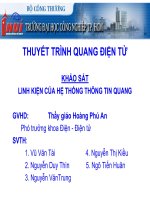PROTEIN SYNTHESIS (thuyết trình)
Bạn đang xem bản rút gọn của tài liệu. Xem và tải ngay bản đầy đủ của tài liệu tại đây (696.88 KB, 59 trang )
PROTEIN
SYNTHESIS
1
Protein Synthesis
The production (synthesis) of
polypeptide chains (proteins)
Two phases:
Transcription & Translation
mRNA must be processed before it
leaves the nucleus of eukaryotic cells
2
DNA → RNA → Protein
DNA
Transcription
mRNA
Ribosome
Translation
Protein
Prokaryotic Cell
3
DNA → RNA → Protein
Nuclear
membrane
DNA
Transcription
Eukaryotic
Cell
Pre-mRNA
RNA Processing
mRNA
Ribosome
Translation
Protein
4
Pathway to Making a
Protein
DNA
mRNA
tRNA (ribosomes)
Protein
5
Nucleic Acids
6
DNA or Protein?
Walter Sutton discovered
chromosomes were made of
DNA and Protein
However, scientists were
NOT sure which one (protein
or DNA) was the actual
genetic material of the cell
7
DNA!
Frederick Griffith
in 1928 showed the
DNA was the cell’s
genetic material
Watson & Crick in
the 1950’s built the
1st model of DNA
8
Structure of DNA
DNA is made of subunits called
nucleotides
DNA nucleotides are composed of
a phosphate, deoxyribose sugar,
and a nitrogen-containing base
The 4 bases in DNA are: adenine
(A), thymine (T), guanine (G),
and cytosine (C)
9
DNA Nucleotide
10
Base Pairing Rule
• Watson and Crick showed that DNA
is a double helix
• A (adenine) pairs with T (thymine)
• C (cytosine) pairs with G (guanine)
11
Nitrogen Rings
• Purines have single rings of
carbon-nitrogen (G, A)
• Pyrimidines have double carbonnitrogen rings (C, T)
• This is called complementary
base pairing because a purine is
always paired with a pyrimidine
12
.
5’ to 3’ Sugars
When the DNA double helix
unwinds, it resembles a ladder
The sides of the ladder are
the sugar-phosphate backbones
The rungs of the ladder are
the complementary paired bases
The two DNA strands are antiparallel (they run in opposite
directions)
13
AntiParallel
Strands
of DNA
14
DNA
Replication
15
Steps in DNA Replication
Occurs when chromosomes duplicate
(make copies)
An exact copy of the DNA is produced
with the aid of the enzyme DNA
polymerase
Hydrogen bonds between bases break
and enzymes “unzip” the molecule
Each old strand of nucleotides serves as
a template for each new strand
New nucleotides move into complementary
positions are joined by DNA polymerase
16
Two New,
Identical
DNA
Strands
Result
from
Replication
17
Another View of Replication
18
RNA
19
RNA Differs from DNA
1. RNA has a sugar ribose
DNA has a sugar deoxyribose
2. RNA contains the base uracil
(U)
DNA has thymine (T)
3. RNA molecule is single-stranded
DNA is double-stranded
20
Structure of RNA
21
.
Three Types of RNA
• Messenger RNA (mRNA) carries
genetic information to the
ribosomes
• Ribosomal RNA (rRNA), along
with protein, makes up the
ribosomes
• Transfer RNA (tRNA) transfers
amino acids to the ribosomes
where proteins are synthesized
22
Making a
Protein
23
Genes & Proteins
Proteins are made of amino
acids linked together by peptide
bonds
20 different amino acids exist
Amino acids chains are called
polypeptides
Segment of DNA that codes for
the amino acid sequence in a
protein are called genes
24
Two Parts of Protein
Synthesis
Transcription makes an RNA
molecule complementary to a
portion of DNA
Translation occurs when the
sequence of bases of mRNA
DIRECTS the sequence of amino
acids in a polypeptide
25









